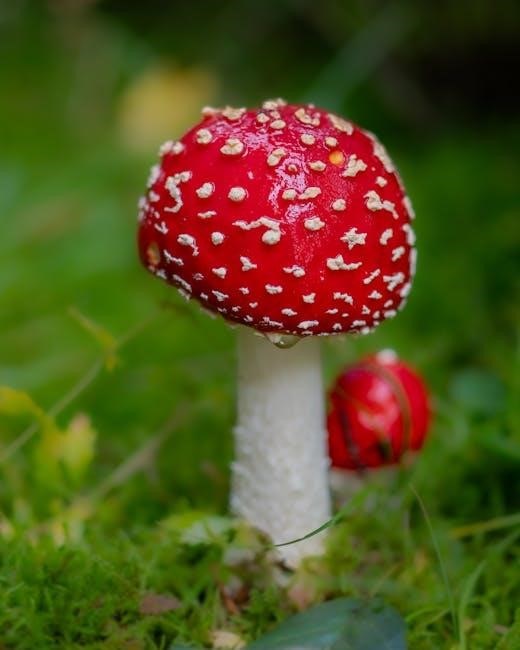Ohio offers a diverse range of wild mushrooms, from edible species like morels and oyster mushrooms to poisonous varieties such as destroying angels. Accurate identification is crucial for safety and ecological balance, ensuring responsible foraging and conservation of fungal species.
Overview of Mushroom Diversity in Ohio
Ohio’s diverse landscapes support a wide variety of wild mushrooms, ranging from edible species like morels, oyster, and chanterelles to poisonous varieties such as destroying angels and false morels. The state’s mix of forests, fields, and urban areas creates habitats for over 500 species, making it a rich region for fungal exploration. Understanding this diversity is essential for safe and sustainable foraging practices in Ohio’s ecosystems.
Importance of Accurate Mushroom Identification
Accurate mushroom identification is critical for safety, as Ohio hosts both edible and highly poisonous species. Misidentification can lead to severe health risks, including organ failure or even death. Proper identification also supports sustainable foraging, preserving fungal populations for future generations. Additionally, it aids in ecological conservation by protecting rare species and maintaining biodiversity in Ohio’s diverse habitats.
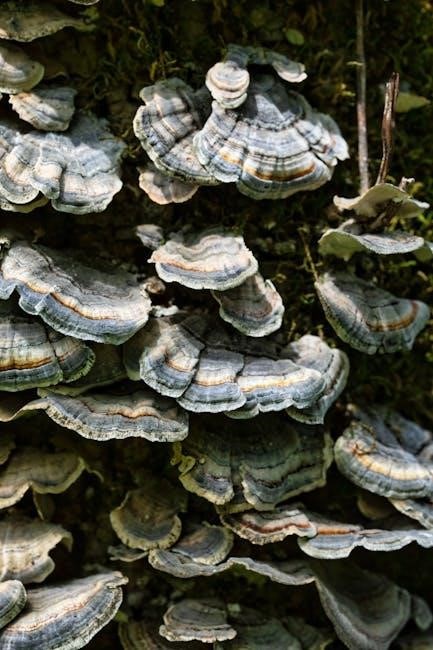
Understanding Mushroom Habitats in Ohio
Ohio’s diverse ecosystems, from forests to fields and urban areas, support a wide variety of mushroom species, each thriving in specific soil, moisture, and vegetation conditions.
Forests and Woodlands
Ohio’s forests and woodlands are rich with diverse fungal species. Deciduous and coniferous trees provide ideal habitats for mushrooms like morels, oyster mushrooms, and chanterelles. These areas often feature moist soil, decaying wood, and leaf litter, which support growth. Morels typically emerge near ash, elm, or poplar trees, while oyster mushrooms thrive on decaying logs. Chanterelles prefer mature forests with coniferous trees. Seasonal variations, such as spring rains, promote abundant growth in these ecosystems.
Fields and Meadows
Ohio’s fields and meadows host a variety of wild mushrooms, including fairy rings, puffballs, and horse mushrooms. These open areas often feature grasses and rich soil, providing ideal conditions for species like Agaricus campestris and Marasmius oreades. Mushrooms in these habitats typically thrive in warm, sunny spots, especially after summer rains. Fields near trees may also yield surprises, as some species prefer the transition zones between grasslands and woodlands. Timing your search in late summer and early fall can yield abundant finds;
Urban and Suburban Areas
Urban and suburban areas in Ohio can surprisingly harbor a variety of mushrooms, particularly in parks, gardens, and green spaces. Species like oyster mushrooms (Pleurotus ostreatus) often grow on trees or decaying wood, while paddy straw mushrooms (Volvariella volvacea) may appear in mulched gardens. Lawns and landscaping sometimes yield fairy rings or button mushrooms. Even in these developed environments, careful observation and identification are essential to distinguish edible species from potentially harmful ones, ensuring safe and enjoyable foraging.
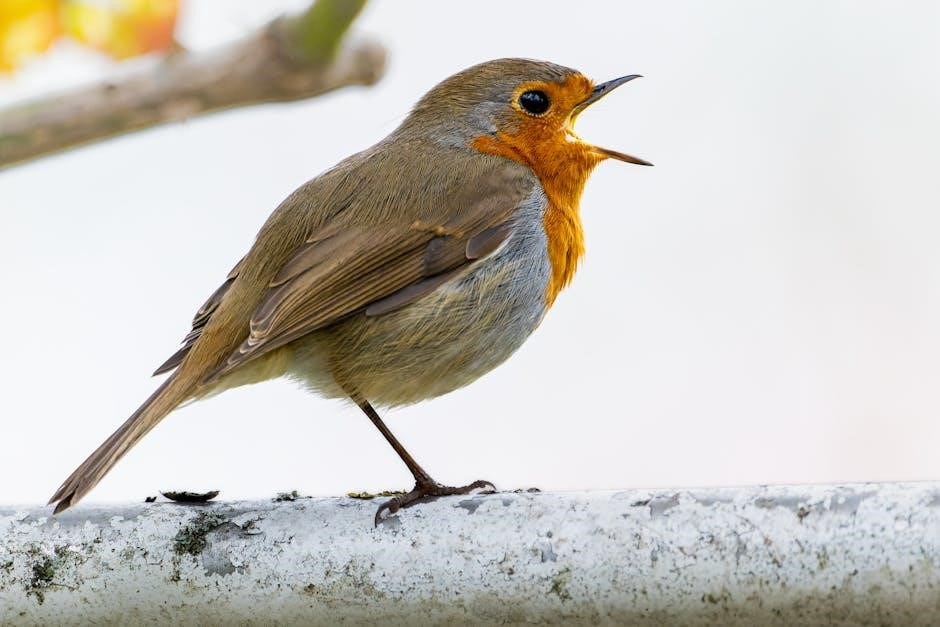
Seasonal Mushroom Growth in Ohio
Ohio’s mushroom growth varies by season, with spring hosting morels, summer featuring oyster mushrooms, fall showcasing chanterelles, and winter offering hardy species like oyster mushrooms.
Spring Mushrooms
Spring is a prime season for mushroom growth in Ohio, with species emerging as temperatures rise and rainfall increases. Morel mushrooms are highly sought after, often found near ash, elm, and poplar trees. Other spring varieties include puffed pigs and inky caps, which thrive in moist woodlands and fields. Early spring mushrooms typically fruit before tree leaves fully expand, taking advantage of cooler, damper conditions. Foragers should look for areas with rich soil and decaying organic matter, using field guides to ensure accurate identification.
Summer Mushrooms
Summer in Ohio brings warmth and humidity, ideal for a variety of mushroom species. Oyster mushrooms thrive in shaded, moist areas, while chanterelles fruit in woodlands. Summer species often exhibit vibrant colors and unique shapes, attracting foragers. Key habitats include deciduous forests, fields, and areas near decaying wood. Foragers should search near tree bases, logs, and shaded spots, using field guides to distinguish edible species like chanterelles from potentially poisonous lookalikes.
Fall Mushrooms
Fall in Ohio is a prime season for mushroom growth, with cooler temperatures and increased moisture fostering a variety of species. Edible mushrooms like chanterelles and oyster mushrooms thrive in deciduous forests, while poisonous varieties such as destroying angels and false morels also appear. Foragers should exercise caution, using field guides to distinguish between safe and dangerous species, ensuring responsible and safe harvesting.
Winter Mushrooms
Winter offers a quieter mushroom season in Ohio, with fewer species active due to cold temperatures. Hardy varieties like winter chanterelles and oyster mushrooms can still be found, often in sheltered areas with suitable humidity. The season requires keen observation, as many winter mushrooms are small or camouflaged. Foragers should remain vigilant, using spore prints and microscopy to ensure accurate identification, especially since some species may resemble their more toxic relatives.
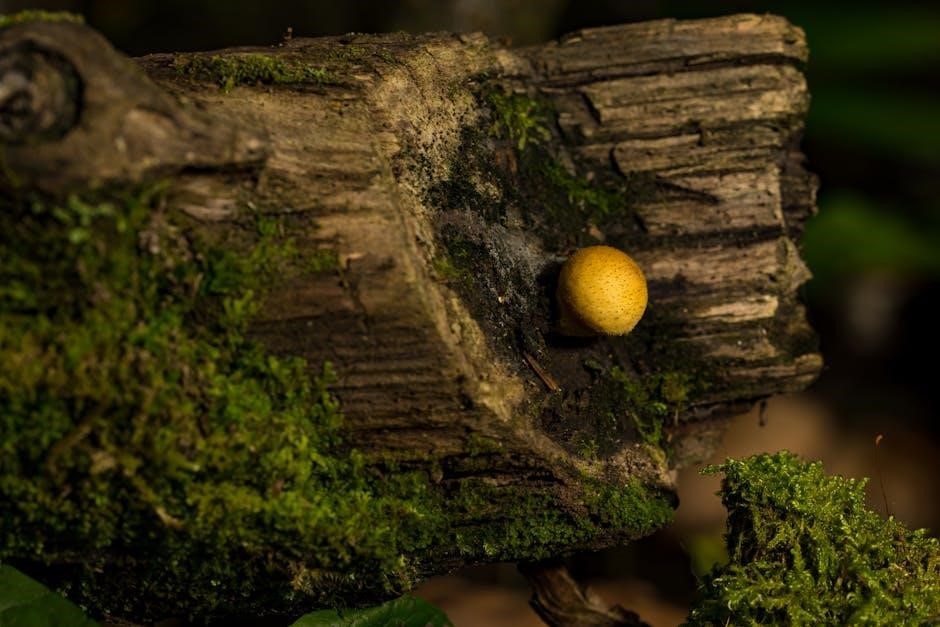
Key Characteristics for Mushroom Identification
Identifying mushrooms relies on observing cap shape, size, color, stem features, gill or pore structures, and spore prints. These traits vary widely among species, aiding accurate classification;
Cap Shape, Size, and Color
- Mushroom caps vary in shape, from bell-shaped to conical, flat, or even irregular forms like morels.
- Size ranges from tiny (less than 1 cm) to large (over 10 inches in diameter), such as certain oyster mushrooms.
- Color is highly variable, with species displaying hues like bright orange, yellow, white, or earthy browns.
- Cap color may change with age or environmental conditions, and some species have distinctive patterns or shading.
- These traits, combined with habitat and season, are essential for accurate identification in Ohio.
Stem and Gills
- Mushroom stems vary in length, thickness, and color, providing key identification clues.
- Some species, like oyster mushrooms, have short, stubby stems, while others, such as chanterelles, lack a distinct stem.
- Gills can be attached, free, or descending, with varying colors and spacing.
- Gill arrangement and spore production are critical for distinguishing edible species from poisonous lookalikes in Ohio.
A spore print is a crucial tool for identifying mushrooms. By placing a mature cap on white paper and covering it, the spores fall, creating a pattern. The color of the spore print—ranging from white to dark brown or black—helps narrow down species. This method is especially useful for distinguishing between similar-looking mushrooms, ensuring accurate identification in Ohio’s diverse fungal landscape.
Common Edible Mushrooms in Ohio
Ohio is home to sought-after edible mushrooms like morels, oyster mushrooms, and chanterelles, each offering unique flavors and textures for culinary enthusiasts and foragers.
Morel Mushrooms
Morel mushrooms are highly prized for their unique, honeycomb-like appearance and delicate flavor. In Ohio, they typically grow in moist, wooded areas with rich soil, often near ash, elm, or poplar trees; Seasonal foraging usually occurs in spring, with peak activity from late March to early May. Successful hunters often locate them in areas with decaying wood or near old apple orchards. Responsible foraging practices are essential to preserve these elusive fungi for future generations.
Oyster Mushrooms
Oyster mushrooms (Pleurotus ostreatus) are a common edible species in Ohio, recognizable by their oyster-shaped caps, typically ranging from 1 to 4 inches in size. They often grow on decaying wood, stumps, or trees, thriving in shaded, moist environments. While they can fruit throughout the year, peak activity occurs in spring and fall. Their mild, buttery flavor makes them a favorite for cooking. Look for white, gill-like structures underneath the cap to confirm identification.
Chanterelle Mushrooms
Chanterelle mushrooms (Cantharellus cibarius) are prized for their funnel-shaped caps with wavy, wrinkled surfaces. Common in Ohio’s hardwood forests, they appear in late summer and fall. Their fruity, apricot-like aroma and peach-colored flesh make them distinctive. The gills are forked and run down the stem, distinguishing them from lookalikes. Chanterelles are edible and highly sought after for their rich, earthy flavor. They thrive in rich, moist soil, often near oak or maple trees.
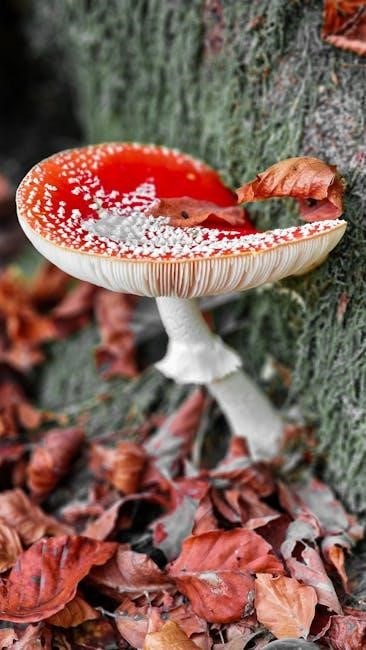
Common Poisonous Mushrooms in Ohio
Ohio is home to several poisonous mushrooms, including destroying angels and false morels. These species can cause severe illness or death if ingested, emphasizing the need for careful identification and caution when foraging for wild mushrooms.
Destroying Angels
The destroying angel (Amanita virosa) is a highly poisonous mushroom found in Ohio. It has a white, bulbous cap and a volva at the base. Ingestion leads to severe liver and kidney damage, often fatal if not treated promptly. It resembles edible mushrooms like the paddy straw mushroom, making accurate identification critical to avoid deadly mistakes. Handling or consuming this species is extremely dangerous and should be strictly avoided.
False Morels
False morels, such as species in the genus Gyromitra, are known for their brain-like appearance and are highly toxic. They often resemble edible morels but contain a toxic compound that can cause severe illness or death if ingested. These mushrooms grow in various habitats, including forests and woodlands, and can be misleading due to their unique shape. Proper identification is crucial, as some false morels can be fatal if consumed without proper preparation.
Deadly Webcaps
Deadly webcaps are highly toxic mushrooms found in Ohio, often resembling edible species but containing lethal compounds. They typically have a conical cap and white gills, growing in grassy areas or at the edges of woodlands. These mushrooms can cause severe illness, organ failure, and death if ingested. Proper identification is critical, as they are easily confused with safer varieties. Expert knowledge is essential to avoid this dangerous species during foraging.
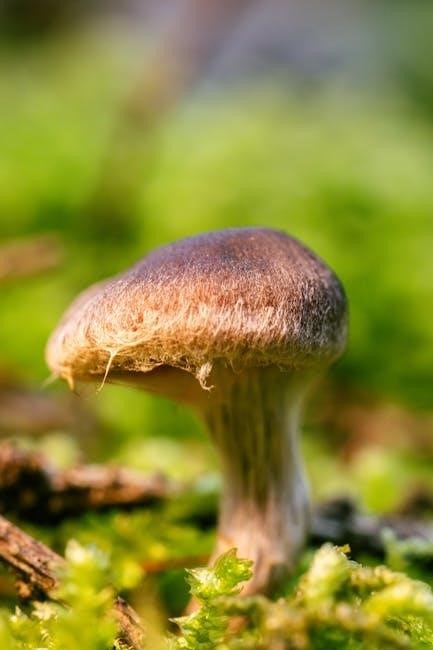
Mushroom Identification Tools and Resources
Essential tools include field guides, online databases, and microscopy for accurate identification. Resources like Ohio-specific guides and apps provide detailed descriptions, images, and expert insights for safe foraging practices.
Field Guides Specific to Ohio
Field guides tailored to Ohio’s fungal diversity are indispensable for accurate identification. Popular titles include Mushrooms of Ohio and Edible Wild Mushrooms of Illinois and Indiana, which cover the Midwest. These guides feature detailed descriptions, high-quality images, and habitat information, helping enthusiasts distinguish edible species like morels and oyster mushrooms from deadly lookalikes such as destroying angels and false morels. They also highlight seasonal growth patterns, ensuring foragers can locate species effectively throughout the year.
Online Databases and Apps
Digital tools enhance mushroom identification in Ohio. Apps like iNaturalist and Mushroom Expert allow users to upload photos for community identification. Online databases, such as MyCoBank and MushroomObserver, provide detailed species profiles. These resources offer real-time data, helping foragers recognize species accurately and stay updated on local sightings. They complement field guides, making identification more accessible and efficient for both novices and experienced enthusiasts.
Microscopy for Advanced Identification
Microscopy is a powerful tool for advanced mushroom identification in Ohio. It allows detailed examination of spore shapes, sizes, and surface patterns, crucial for distinguishing similar species. By mounting samples in water or potassium hydroxide (KOH), enthusiasts can study gill and veil structures under magnification. This method is particularly useful for confirming the identity of rare or lookalike species, ensuring accurate classification and safe foraging practices among enthusiasts and researchers alike.

Legal Considerations for Mushroom Foraging in Ohio
Ensure you have permission to forage on private lands and obtain permits for public areas. Adhere to regulations and practice sustainable harvesting to protect ecosystems and rare species.
Public vs. Private Lands
Foraging on public lands, such as state parks, often requires permits and may have quantity restrictions. Private lands necessitate landowner permission to ensure legality and ethical foraging practices. Trespassing or collecting without authorization can lead to legal consequences. Always verify local regulations and respect property rights to maintain sustainable and responsible mushroom harvesting practices in Ohio.
Permits and Regulations
In Ohio, foraging for mushrooms on public lands, such as state parks or forests, often requires a permit. These permits may limit the quantity of mushrooms you can collect to ensure sustainability. Private lands require landowner permission. Regulations vary by location, so it’s essential to check with the Ohio Department of Natural Resources for specific rules. Failure to comply can result in fines or legal consequences, emphasizing the importance of adhering to local guidelines.
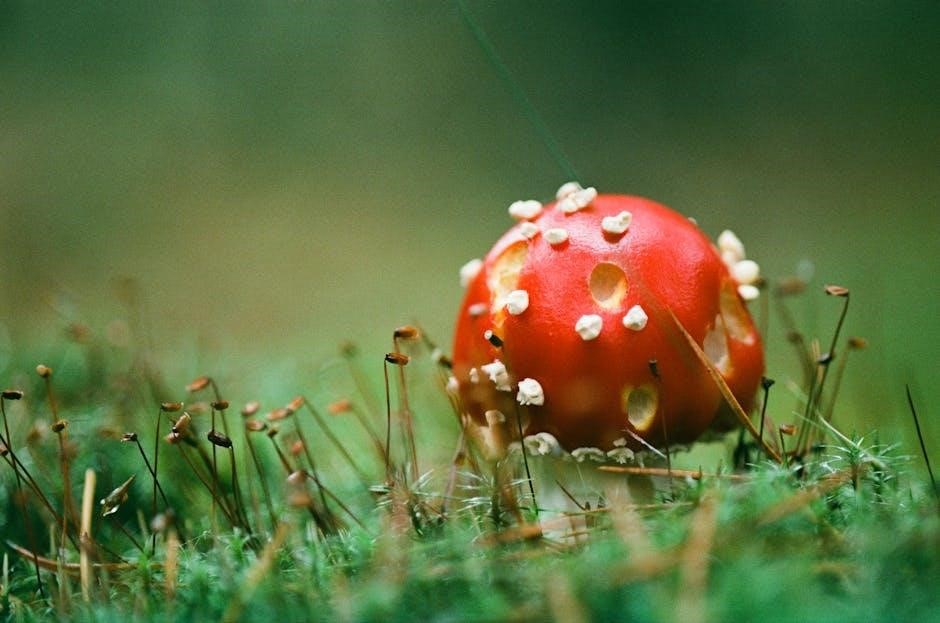
Advanced Mushroom Identification Techniques
Advanced methods include microscopy for spore analysis and chemical tests to confirm species. These techniques require expertise and specialized tools for accurate identification of Ohio’s diverse mushrooms.
Spore Print Analysis
Spore print analysis is a critical technique for mushroom identification, revealing the color and pattern of spores. To obtain a spore print, place the mushroom cap on white paper, cover it, and let it sit. The resulting print helps determine species by spore color, which can be white, yellow, brown, or purple. This method is essential for distinguishing similar species and confirming identifications, especially for advanced foragers seeking precise classification of Ohio’s diverse fungi.
Chemical Tests for Mushrooms
Chemical tests, such as the KOH or ammonia test, are advanced methods for identifying mushrooms. These tests reveal specific reactions that help distinguish species. For example, applying a drop of potassium hydroxide (KOH) to the cap can cause a color change, aiding in identification. Such tests are particularly useful for confirming species that are difficult to identify through physical characteristics alone, ensuring accurate and safe foraging in Ohio’s diverse fungal landscape.
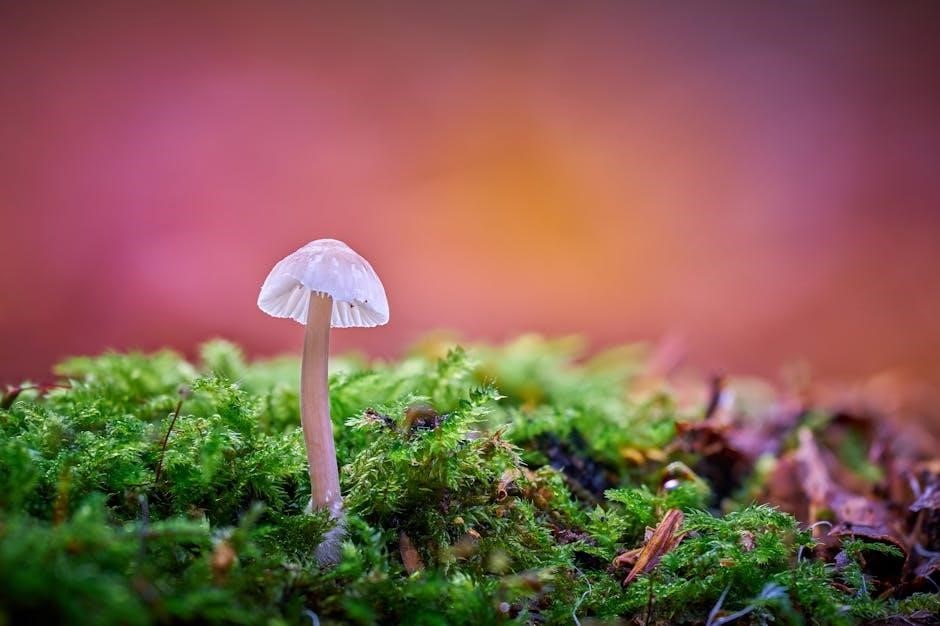
Conservation and Sustainability in Mushroom Foraging
Responsible foraging practices, like avoiding over-harvesting and minimizing habitat disruption, are essential for preserving Ohio’s fungal diversity and ensuring sustainable ecosystems for future generations.
Responsible Foraging Practices
Responsible foraging involves harvesting mushrooms sustainably by avoiding over-picking, especially rare species. Foragers should only collect what they need, leaving enough to ensure spore dispersal. Harvesting tools should minimize habitat damage, and sensitive areas like protected forests should be avoided. Additionally, respecting private property and adhering to local regulations ensures ethical and environmentally friendly mushroom collection. These practices help maintain Ohio’s rich fungal biodiversity for future generations.
Protecting Rare and Endangered Species
Protecting rare and endangered mushroom species requires careful conservation efforts. Avoid harvesting vulnerable species, as over-collection can threaten their survival. Support conservation initiatives and report sightings of rare fungi to researchers. Educating others about the importance of fungal diversity helps safeguard these species. Additionally, adhering to local regulations and avoiding habitats of endangered mushrooms are vital steps in preserving Ohio’s fragile fungal ecosystems for future generations.
Common Mistakes in Mushroom Identification
A common mistake is relying solely on photos for identification without examining key features like gills, stems, or spore prints. Overlooking these details can lead to misidentification.
Overlooking Key Features
One of the most frequent errors in mushroom identification is failing to thoroughly examine critical characteristics. Rushing the process or neglecting to inspect the cap, gills, stem, and spore print can lead to misidentification. For example, the delicate patterns on a morel or the volva at the base of a destroying angel are essential for accurate ID. Always prioritize detailed observation over hasty conclusions to ensure safety and accuracy in identification efforts.
Misidentifying Similar Species
Misidentifying similar species is a common mistake in mushroom identification, often due to overlapping physical characteristics. For example, edible chanterelles can be confused with poisonous lookalikes like jack o’lanterns. Similarly, morels and false morels share a resemblance but differ in critical ways. Such errors can lead to serious health risks. Always cross-reference multiple field guides and consult experts when unsure to avoid dangerous mix-ups and ensure accurate identification of Ohio’s diverse fungal species.
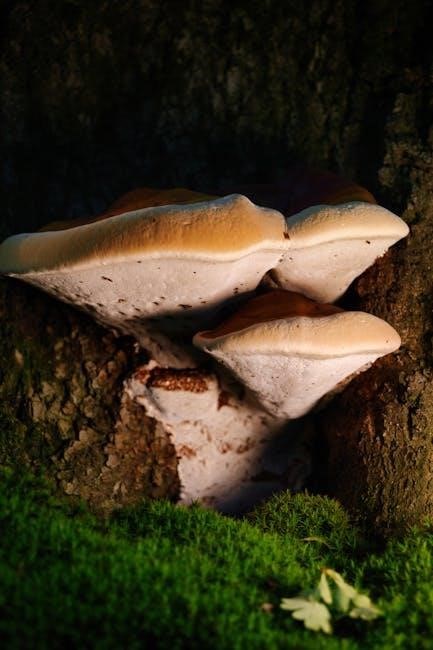
Future of Mushroom Identification in Ohio
The future of mushroom identification in Ohio lies in advancing technology, like AI-powered apps and DNA analysis, while addressing climate change’s impact on species distribution and emergence.
Role of Technology in Identification
Technology is revolutionizing mushroom identification in Ohio through AI-powered apps, digital databases, and advanced microscopy. These tools enhance accuracy by analyzing spore prints and cap features, making identification more accessible and reliable for both experts and enthusiasts. Online platforms now offer real-time species verification, reducing errors and fostering a community-driven approach to mycology. Such innovations ensure safer and more efficient foraging experiences across the state’s diverse ecosystems.
Emerging Species and Climate Change
Climate change is altering Ohio’s fungal landscape, potentially introducing new species while threatening others. Rising temperatures and shifting rainfall patterns may disrupt symbiotic relationships, affecting mushroom habitats. Researchers are exploring these changes, including the discovery of emerging species in diverse ecosystems. Invasive fungi, such as non-native mushrooms, are also appearing, challenging identification efforts and ecological balance. These shifts highlight the need for ongoing research and conservation to protect Ohio’s mycological diversity.
